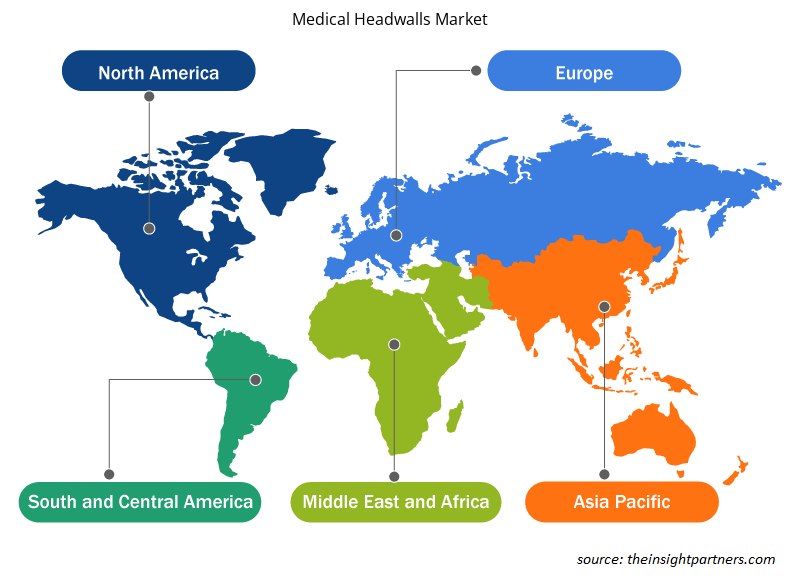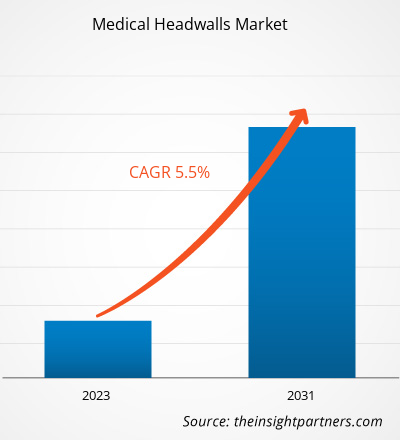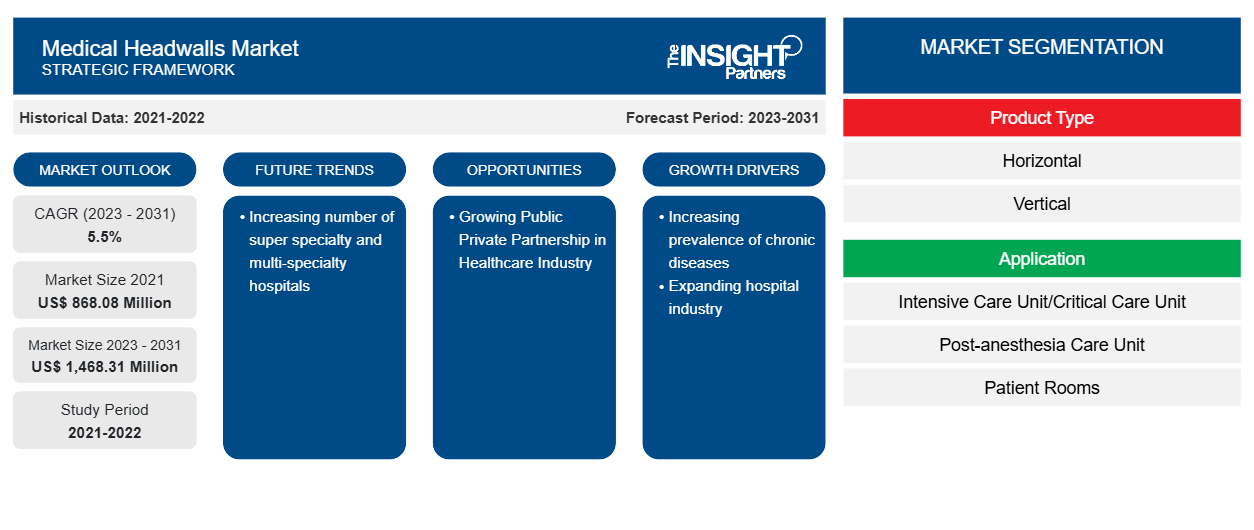En 2021, la taille du marché des murs de tête médicaux s'élevait à 868,08 millions USD et devrait atteindre 1 468,31 millions USD d'ici 2031, contre XX milliards USD en 2023. Le marché devrait enregistrer un TCAC de 5,5 % en 2023-2031. Le nombre croissant d'hôpitaux super spécialisés et multispécialisés et le développement des infrastructures devraient rester les principales tendances du marché des murs de tête médicaux.headwalls market size in 2021 stood at US$ 868.08 million and is projected to reach US$ 1,468.31 million by 2031 from US$ XX billion in 2023. The market is expected to register a CAGR of 5.5% in 2023–2031. Increasing number of super specialty and multispecialty hospitals and infrastructure development are likely to remain key medical headwalls market trends.
Analyse du marché des murs de tête médicauxHeadwalls Market Analysis
Le marché des murs de tête médicaux devrait augmenter en raison de facteurs tels que la prévalence croissante des maladies chroniques et l'expansion du secteur hospitalier. En outre, l'augmentation des partenariats public-privé dans le secteur de la santé contribuera à la croissance du marché dans les années à venir.
Aperçu du marché des murs de tête médicaux
Les murs de tête médicaux sont essentiels dans les hôpitaux, les maisons de retraite , les hôpitaux spécialisés, les hôpitaux multispécialités et d'autres environnements. Les murs de tête sont des systèmes de gestion d'équipements montés au mur qui fournissent des services électriques et des sorties de distribution horizontales pour les gaz médicaux tels que l'oxygène, l'air et le vide. Les murs de tête d'hôpital devraient augmenter régulièrement sur le marché futur. Cependant, la diversification des produits, la réduction des coûts et l'optimisation de la chaîne d'approvisionnement sont toujours essentielles pour l'adoption généralisée du mur de tête d'hôpital. La préférence croissante pour les soins de santé à domicile est susceptible d'entraver la croissance du marché.
Personnalisez ce rapport en fonction de vos besoins
Vous bénéficierez d'une personnalisation gratuite de n'importe quel rapport, y compris de certaines parties de ce rapport, d'une analyse au niveau des pays, d'un pack de données Excel, ainsi que d'offres et de remises exceptionnelles pour les start-ups et les universités.
-
Obtenez les principales tendances clés du marché de ce rapport.Cet échantillon GRATUIT comprendra une analyse de données, allant des tendances du marché aux estimations et prévisions.
Moteurs et opportunités du marché des murs de tête médicaux
L'augmentation des barrières médicales dans le monde entier favorise la croissance du marché
L'augmentation du nombre d'hospitalisations quotidiennes a entraîné une augmentation du nombre d'hôpitaux et de cliniques privés. Les hôpitaux passent d'une construction de murs de tête en bois à un système de gestion des équipements monté sur mur pour faciliter l'expérience du personnel médical, des patients et des visiteurs. Ainsi, la prévalence croissante de maladies chroniques comme les maladies cardiovasculaires, le cancer, le diabète et d'autres est responsable de l'augmentation du nombre d'hospitalisations, ce qui stimule la croissance du marché des murs de tête médicaux.
Croissance des partenariats public-privé dans le secteur de la santé
Les systèmes de santé sont de plus en plus intégrés, répondant aux besoins de soins tout au long de la chaîne de soins et utilisant la technologie pour améliorer la prestation. Les PPP se sont concentrés sur le développement et la reconstruction d'infrastructures hospitalières essentielles ; les PPP intégrés ont intégré la prestation de services cliniques et les méthodes de gestion du secteur privé pour améliorer la qualité des soins et l'accès aux soins spécialisés. Par exemple, il a renforcé les services hospitaliers d'urgence dans l'un des districts les plus négligés du Brésil. Le gouvernement local a engagé la Société financière internationale (IFC), membre du Groupe de la Banque mondiale, pour mettre en œuvre le cadre PPP pour le nouvel hôpital.PPPs focused on developing and rebuilding crucial hospital infrastructure; integrated PPPs incorporated clinical service delivery and private sector management methods to improve care quality and access to specialized care. For example, strengthen emergency hospital services in one of Brazil's most neglected districts. The local government engaged the International Finance Corp. (IFC), a member of the World Bank Group, to implement the PPP framework for the new hospital.
Analyse de segmentation du rapport sur le marché des murs de tête médicauxHeadwalls Market Report Segmentation Analysis
Les segments clés qui ont contribué à l’élaboration de l’analyse du marché des têtes de lit médicales sont le type de produit et l’application.headwalls market analysis are product type and application.
- En fonction du type de produit, le marché des murs de tête médicaux est divisé en segments horizontaux et verticaux. Le segment horizontal détenait une part de marché plus importante en 2023.headwalls market is bifurcated into horizontal and vertical. The horizontal segment held a larger market share in 2023.
- En termes d'application, le marché est divisé en unités de soins intensifs (USI)/unités de soins critiques (USC), unités de soins post-anesthésiques (USPA), chambres de patients et autres applications. Le segment des unités de soins intensifs (USI)/unités de soins critiques (USC) détenait la plus grande part du marché en 2023.
Analyse des parts de marché des murs de tête médicaux par géographie
La portée géographique du rapport sur le marché des têtes de lit médicales est principalement divisée en cinq régions : Amérique du Nord, Asie-Pacifique, Europe, Moyen-Orient et Afrique, et Amérique du Sud et centrale.
L'Amérique du Nord domine le marché des murs de tête médicaux. La croissance prévue du marché des murs de tête médicaux est attribuée à la présence d'un grand nombre d'hôpitaux dans la région. De plus, la prévalence croissante des maladies chroniques, associée aux initiatives prises par les acteurs régionaux, devrait alimenter la croissance du marché au cours de la période de prévision.
Aperçu régional du marché des murs de tête médicaux
Les tendances régionales et les facteurs influençant le marché des murs de tête médicaux tout au long de la période de prévision ont été expliqués en détail par les analystes d’Insight Partners. Cette section traite également des segments et de la géographie du marché des murs de tête médicaux en Amérique du Nord, en Europe, en Asie-Pacifique, au Moyen-Orient et en Afrique, ainsi qu’en Amérique du Sud et en Amérique centrale.

- Obtenez les données régionales spécifiques au marché des murs de tête médicaux
Portée du rapport sur le marché des murs de tête médicaux
| Attribut de rapport | Détails |
|---|---|
| Taille du marché en 2021 | 868,08 millions de dollars américains |
| Taille du marché d'ici 2031 | 1 468,31 millions de dollars américains |
| Taux de croissance annuel composé mondial (2023-2031) | 5,5% |
| Données historiques | 2021-2022 |
| Période de prévision | 2023-2031 |
| Segments couverts |
Par type de produit
|
| Régions et pays couverts |
Amérique du Nord
|
| Leaders du marché et profils d'entreprises clés |
|
Densité des acteurs du marché des murs de tête médicaux : comprendre son impact sur la dynamique commerciale
Le marché des murs-rideaux médicaux connaît une croissance rapide, tirée par la demande croissante des utilisateurs finaux en raison de facteurs tels que l'évolution des préférences des consommateurs, les avancées technologiques et une plus grande sensibilisation aux avantages du produit. À mesure que la demande augmente, les entreprises élargissent leurs offres, innovent pour répondre aux besoins des consommateurs et capitalisent sur les tendances émergentes, ce qui alimente davantage la croissance du marché.
La densité des acteurs du marché fait référence à la répartition des entreprises ou des sociétés opérant sur un marché ou un secteur particulier. Elle indique le nombre de concurrents (acteurs du marché) présents sur un marché donné par rapport à sa taille ou à sa valeur marchande totale.
Les principales entreprises opérant sur le marché des murs-rideaux médicaux sont :
- Dragerwerk AG & Co. Kgaa
- Mindray
- SYSTÈMES INTERSPEC
- Classe 1 Inc.
- GROUPE DE SOCIÉTÉS AMICO
- Systèmes hospitaliers, Inc.
Avis de non-responsabilité : les sociétés répertoriées ci-dessus ne sont pas classées dans un ordre particulier.

- Obtenez un aperçu des principaux acteurs du marché des murs-rideaux médicaux
Actualités et développements récents du marché des murs de tête médicaux
Le marché des murs de tête médicaux est évalué en collectant des données qualitatives et quantitatives après des recherches primaires et secondaires, qui comprennent d'importantes publications d'entreprise, des données d'association et des bases de données. Voici une liste des évolutions du marché des murs de tête médicaux :
- Modular Services Company, le principal fabricant de murs de tête préfabriqués, a lancé le nouveau Form Visualizer, un outil de conception virtuelle qui rend la conception de murs de tête pour les espaces de soins de santé plus facile que jamais. Grâce à cette interface conviviale, les murs de tête de la collection Form peuvent être créés et personnalisés en quelques clics. (Source : Modular Services Company, Newsroom, 2023)
- Class 1 Incorporated (« Class 1 ») a acquis l'entreprise MedCore Services Inc (« MedCore ») et intégrera MedCore aux opérations de Class 1 à compter du 16 janvier 2023. (Source : Class 1 Inc., Newsroom, 2023)
Rapport sur le marché des murs de tête médicaux et livrables
Le rapport « Taille et prévisions du marché des murs de tête médicaux (2021-2031) » fournit une analyse détaillée du marché couvrant les domaines ci-dessous :
- Taille du marché et prévisions aux niveaux mondial, régional et national pour tous les segments de marché clés couverts par le périmètre
- Dynamique du marché, comme les facteurs moteurs, les contraintes et les opportunités clés
- Principales tendances futures
- Analyse détaillée des cinq forces de PEST/Porter et SWOT
- Analyse du marché mondial et régional couvrant les principales tendances du marché, les principaux acteurs, les réglementations et les développements récents du marché
- Analyse du paysage industriel et de la concurrence couvrant la concentration du marché, l'analyse de la carte thermique, les principaux acteurs et les développements récents
- Profils d'entreprise détaillés
- Analyse historique (2 ans), année de base, prévision (7 ans) avec TCAC
- Analyse PEST et SWOT
- Taille du marché Valeur / Volume - Mondial, Régional, Pays
- Industrie et paysage concurrentiel
- Ensemble de données Excel
Rapports récents
Rapports connexes
Témoignages
Raison d'acheter
- Prise de décision éclairée
- Compréhension de la dynamique du marché
- Analyse concurrentielle
- Connaissances clients
- Prévisions de marché
- Atténuation des risques
- Planification stratégique
- Justification des investissements
- Identification des marchés émergents
- Amélioration des stratégies marketing
- Amélioration de l'efficacité opérationnelle
- Alignement sur les tendances réglementaires























 Obtenez un échantillon gratuit pour - Marché des murs de tête médicaux
Obtenez un échantillon gratuit pour - Marché des murs de tête médicaux